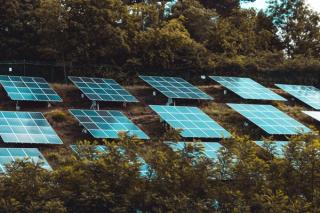
Powering up for net zero: Smart siting and the future of distributed energy
- Post Date
- 14 July 2025
- Read Time
- 7 minutes

For the second article of our Powering up for net zero series, Charlotte Bragg discusses the role of distributed energy generation (DEG) in the energy transition, exploring the importance of strategic site selection and synergy with grid infrastructure, as well as looking ahead to the energy landscape of the future.
See the other articles in this series so far:
UK energy systems are under increasing strain as the shift to net zero accelerates. The drive to decarbonise heat, electricity, and transport demands a radical transformation in how electricity is generated, transmitted, and consumed. While large-scale grid reinforcements remain crucial to meeting rising energy demands, the role of decentralised, smarter solutions is becoming ever more significant.
Strategic site selection and distributed energy generation (DEG) are now key enablers in building a resilient, agile, low-carbon electricity network. At SLR, we are helping shape this transition through our multidisciplinary support for innovative energy projects across the UK.
Understanding distributed energy generation (DEG)
DEG refers to the production of electricity from numerous small-scale sources, often located close to where the power is used. This includes technologies such as rooftop solar panels, wind turbines, anaerobic digestion units, combined heat and power systems, and increasingly, battery storage solutions. By producing power locally, DEG reduces transmission losses, strengthens system resilience, and empowers local communities.
Crucially, DEG can balance local supply and demand, particularly when paired with smart grid technologies that dynamically manage energy flows. In this way, distributed generation not only eases pressure on the wider grid but also supports energy security and affordability.
Global examples are offering valuable insights into the potential of DEG. The South Australia Virtual Power Plant (VPP), for instance, developed in partnership with Tesla, aims to connect up to 50,000 homes equipped with solar panels and battery storage into a single, intelligently controlled energy system. With a projected capacity of 250 MW of generation and 650 MWh of storage, the VPP demonstrates how coordinated, decentralised energy assets can deliver system-level benefits. These kinds of innovations are helping to shape the thinking behind distributed energy projects here in the UK.
Why strategic site selection matters
In the evolving landscape of distributed energy generation (DEG), strategic site selection is more important than ever. The right location must balance grid access, energy demand, land availability, environmental constraints, constructability, and planning policy. Co-locating DEG with industrial or commercial users can reduce energy costs, improve reliability, and support decarbonisation at a local level. Similarly, reusing brownfield or previously developed land can help accelerate project delivery while avoiding competition with agriculture or sensitive landscapes. At SLR, we use advanced GIS tools – including suitability heatmapping, multi-criteria analysis, and AI-assisted spatial modelling – to identify and rank opportunities aligned with project goals.
For co-located DEG projects, this means we can, for example, identify underutilised industrial estates with high electricity demand that are also close to suitable land and existing grid connections. We can also model how different site options might affect local network loads or identify locations where energy generation can best support system resilience. By doing this early in the process, we strengthen the Environmental Impact Assessment (EIA) by evidencing site alternatives, reduce planning risk, and ensure that only realistic, deliverable sites progress to detailed design.
Synergy with grid infrastructure
While DEG enhances local flexibility and resilience, it must operate in tandem with major grid reinforcements. The transition to a decarbonised grid involves expanding transmission capacity, modernising distribution networks, and integrating energy storage. Targeted deployment of DEG can ease strain on specific sections of the grid, postpone the need for costly infrastructure upgrades, and help maintain stability in regions with high levels of renewable energy.
A recent example of this coordinated approach involves a large scale solar and battery storage project in eastern England. The scheme includes a 50 MW solar farm complemented by a 20 MW battery storage facility, strategically situated near key transport and industrial infrastructure. SLR project managed the planning application and associated environmental assessments for this innovative project, aligning it with existing infrastructure and land use plans. It demonstrates how well-sited DEG schemes can strengthen grid resilience and accelerate the integration of renewables.
By coordinating national grid investments with strategically located local energy initiatives, we can create a more balanced and responsive energy system. This integrated approach enables greater hosting capacity for renewables, improves security of supply, and ensures a cost-effective pathway to net zero.
Looking ahead
As the energy landscape evolves, the connection between strategic site selection and distributed generation will only grow stronger. The electrification of heat and transport, the need for negative emissions, and the protection of natural capital all require a grid that is smarter, more distributed, and more flexible.
Well-sited distributed systems can help meet climate goals while delivering tangible benefits to communities and businesses. Combined with innovations like energy parks, smart grid management, and digital monitoring, these solutions will form the backbone of the energy system of the future.
Emerging technologies such as ship-based battery storage are also adding exciting dimensions to grid flexibility. These mobile energy storage units could enable the transfer of stored renewable power between coastal regions with high generation and those with high demand or constrained grid capacity. As the technology matures, ship batteries may become a vital component of the UK’s distributed and flexible energy infrastructure, particularly for island or remote communities and strategic ports.
SLR is uniquely positioned to support clients through every stage of the evolving energy transition.With excellent expertise across the energy sector, we offer a full suite of services, from bespoke routing and siting tools that optimise project locations, to end-to-end management of Environmental Impact Assessments, technical studies, and planning applications. Our integrated teams bring experience in grid connection strategies, smart grid technologies, energy storage, and the development of complex energy parks. We also support full project lifecycles including post-consent compliance, construction support, acquisition and due diligence, environmental monitoring, optimisation, decommissioning, life cycle assessment, and climate resilience planning. Whether it’s identifying viable sites, navigating planning and permitting challenges, or delivering future-ready infrastructure, SLR provides the insight and innovation needed to help clients deliver resilient, sustainable energy solutions that align with net zero ambitions.
About the 'Powering up for net zero' series
The transmission and distribution sector plays a crucial role in the journey to achieve net zero. Our Powering up for net zero article series explores how innovative technologies and solutions – such as smart grid technologies, distributed energy generation, energy storage, and energy parks – can work in tandem with the major grid infrastructure reinforcements underway to meet growing energy demands.
The series looks at the future challenges posed by the electrification of heat and transport, the role of carbon capture and storage in achieving negative emissions, and how sustainable grid expansion can support these ambitious goals. Each article breaks down the ways in which smarter grid management, strategic site selection, and innovative technologies can help us navigate the complexities of the energy transition. Whether it's through optimising supply and demand, integrating renewables, or upgrading infrastructure, these solutions will be key in making the grid fit for a net zero future.
Recent posts
-

-

-

Transforming the Food & Beverage industry: From compliance only to business-driven decarbonisation
by Vincenzo Giordano, Joseph Payne, Stéphane Rapoport
View post